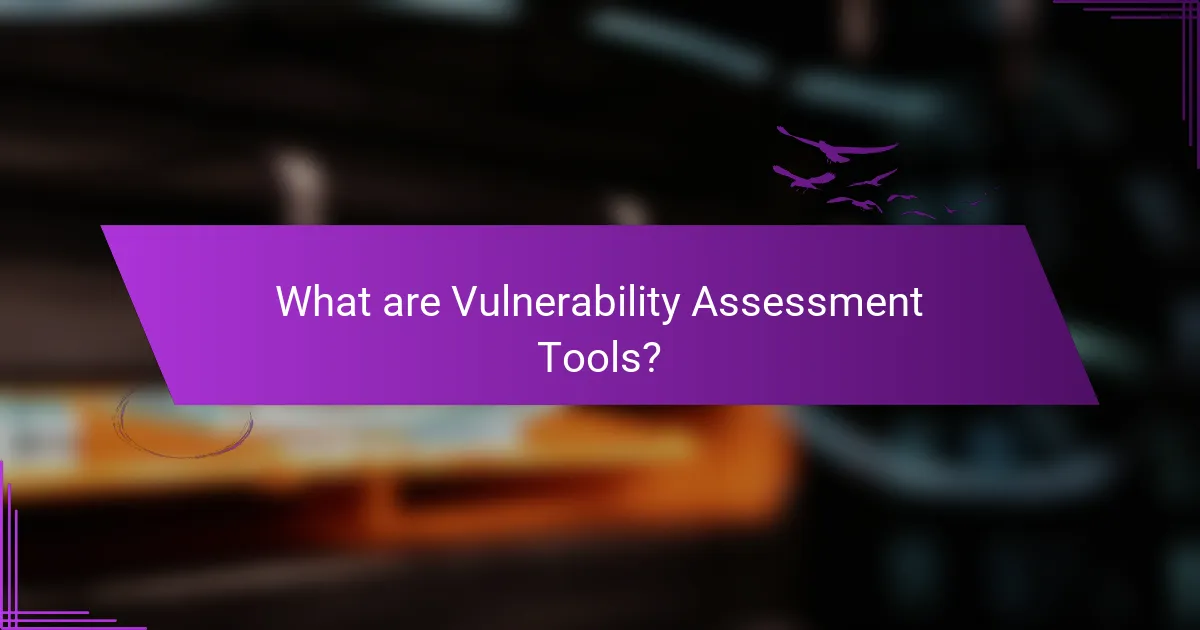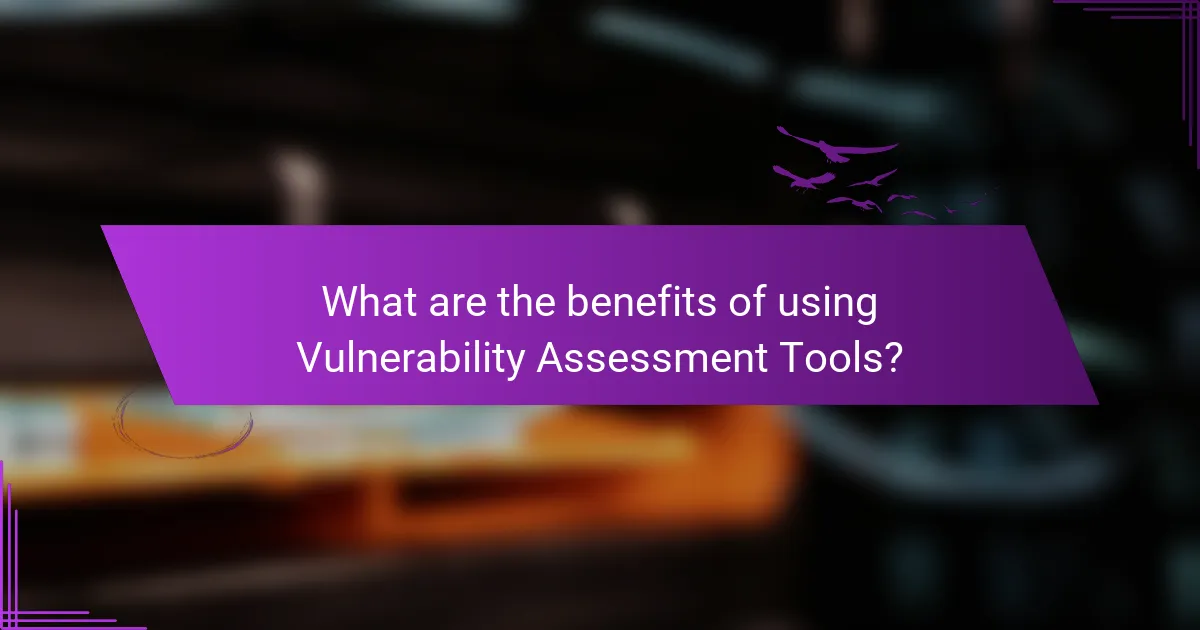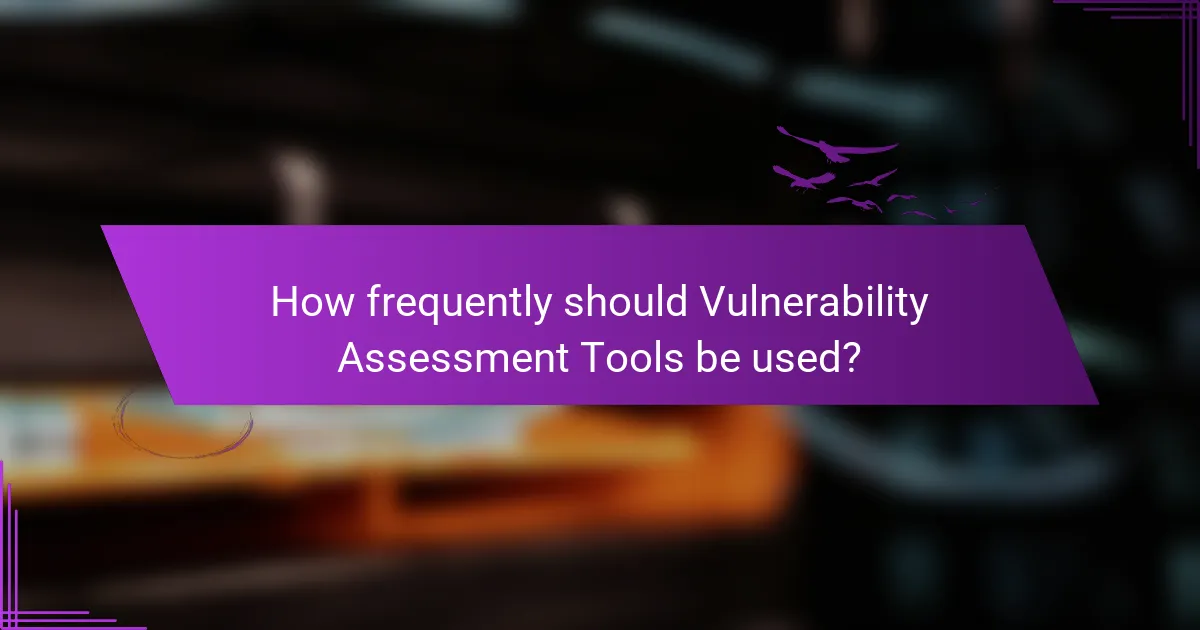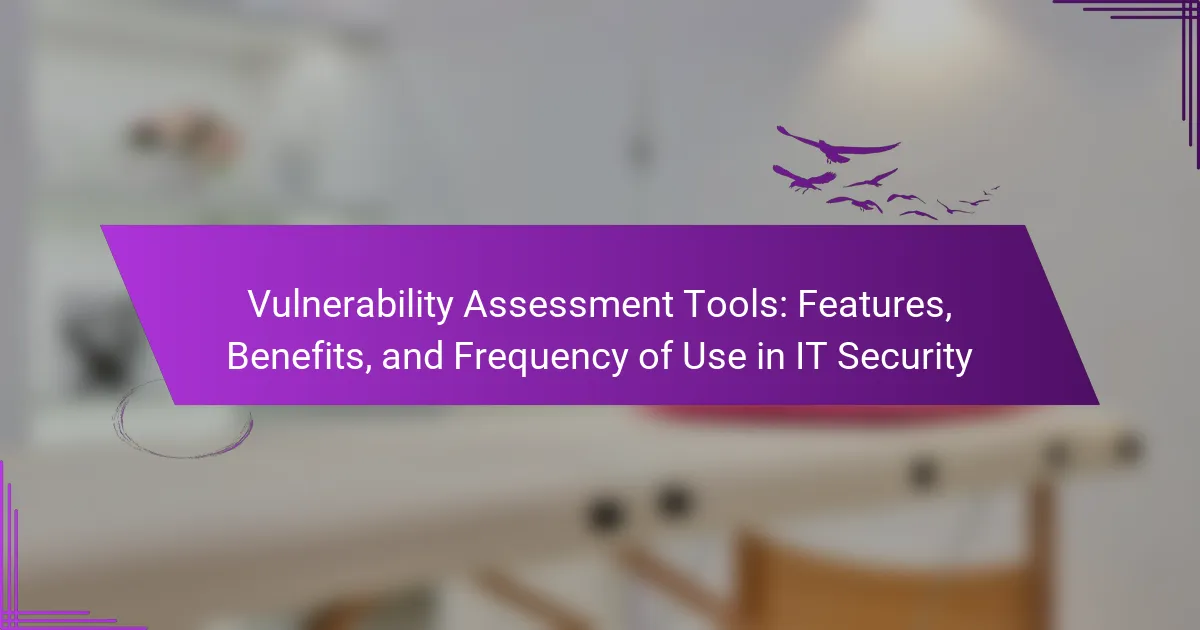
What are Vulnerability Assessment Tools?
Vulnerability assessment tools are software applications designed to identify, quantify, and prioritize vulnerabilities in computer systems, networks, and applications. These tools scan for known weaknesses, misconfigurations, and security flaws. They provide detailed reports that help organizations understand their security posture. Many tools use databases of known vulnerabilities, such as the Common Vulnerabilities and Exposures (CVE) list. Regular use of these tools is essential for maintaining compliance with security standards. They also assist in risk management by allowing organizations to address vulnerabilities before they can be exploited. Effective vulnerability assessment tools enhance overall IT security and reduce potential attack surfaces.
How do Vulnerability Assessment Tools function in IT Security?
Vulnerability assessment tools function by systematically scanning and identifying security weaknesses in IT systems. They utilize various techniques to detect vulnerabilities, including automated scans, configuration checks, and [censured] testing. These tools analyze software, hardware, and network configurations to uncover potential threats. They provide detailed reports that prioritize vulnerabilities based on severity and impact. This allows organizations to address the most critical issues first. Regular use of these tools helps maintain security compliance and reduce the risk of data breaches. According to a study by the SANS Institute, organizations that employ vulnerability assessment tools reduce their risk exposure significantly.
What key components are involved in the operation of Vulnerability Assessment Tools?
Vulnerability Assessment Tools operate through several key components. These components include scanning engines, which identify vulnerabilities in systems and applications. Another component is a database of known vulnerabilities, which provides the necessary context for assessment. Reporting features are also crucial, as they summarize findings and recommend remediation steps. Additionally, integration capabilities allow these tools to work with other security systems. User interfaces facilitate ease of use for security professionals. Finally, scheduling functions enable regular assessments to maintain security posture. Each of these components plays a vital role in the effectiveness of Vulnerability Assessment Tools.
How do these components interact to identify vulnerabilities?
Vulnerability assessment tools interact through several key components to identify vulnerabilities effectively. These components include scanning engines, databases of known vulnerabilities, and reporting mechanisms. Scanning engines probe systems for weaknesses, such as outdated software or misconfigurations. They utilize databases that contain information on known vulnerabilities, which are regularly updated to reflect the latest threats.
When a scan is completed, the reporting mechanism compiles the findings into a structured format. This format often includes severity ratings and remediation recommendations. The interaction between these components allows for comprehensive coverage of potential security gaps. For example, a tool may identify a specific software version that is vulnerable based on the data from its database.
This process ensures that organizations can prioritize vulnerabilities based on risk. Continuous updates to databases improve the accuracy of the assessments. Overall, the synergy between scanning engines, vulnerability databases, and reporting tools enhances the identification of vulnerabilities in IT security systems.
What types of Vulnerability Assessment Tools are available?
There are several types of Vulnerability Assessment Tools available. These tools can be categorized into three main types: network vulnerability scanners, web application scanners, and endpoint vulnerability scanners. Network vulnerability scanners identify vulnerabilities in network devices and configurations. Web application scanners focus on vulnerabilities in web applications, such as SQL injection and cross-site scripting. Endpoint vulnerability scanners assess vulnerabilities on individual devices, including desktops and servers. Each type serves a specific purpose in identifying security weaknesses. This categorization helps organizations choose the right tool based on their specific needs.
What distinguishes automated tools from manual assessment tools?
Automated tools perform assessments without human intervention, while manual assessment tools require human input. Automated tools can quickly analyze large datasets, improving efficiency. They utilize predefined rules and algorithms for consistent results. In contrast, manual tools allow for nuanced analysis and human judgment. Human assessors can adapt to complex scenarios that automated tools may overlook. Automated tools often produce faster results, while manual tools may take longer but can identify unique vulnerabilities. The choice between them depends on the specific needs of the assessment, such as speed versus depth of analysis.
How do specialized tools differ from general-purpose tools?
Specialized tools focus on specific tasks, while general-purpose tools serve multiple functions. Specialized tools are designed for particular applications, enhancing efficiency and accuracy. For example, a vulnerability scanner targets security flaws in software systems. In contrast, a general-purpose tool like a screwdriver can perform various tasks but lacks the precision of specialized devices. The effectiveness of specialized tools often results in faster problem resolution. Research shows that specialized tools can reduce task completion time by up to 50%. This efficiency highlights their importance in fields requiring high precision, such as IT security.

What are the benefits of using Vulnerability Assessment Tools?
Vulnerability Assessment Tools identify security weaknesses in systems and networks. They provide a systematic approach to uncover vulnerabilities. These tools help organizations prioritize risks based on severity. They enable proactive remediation of security issues before exploitation occurs. Regular assessments improve an organization’s security posture. According to a report by the Ponemon Institute, organizations that conduct regular assessments reduce the likelihood of a data breach. Vulnerability Assessment Tools also ensure compliance with industry regulations and standards. They facilitate better incident response by identifying potential attack vectors.
How do Vulnerability Assessment Tools enhance IT Security?
Vulnerability Assessment Tools enhance IT Security by identifying and prioritizing security weaknesses. These tools scan systems for known vulnerabilities, configuration issues, and compliance violations. They provide detailed reports on potential risks, allowing organizations to address them proactively. Regular use of these tools helps maintain a secure environment by ensuring timely updates and patches. According to a study by the SANS Institute, organizations that implement vulnerability assessments reduce their risk of breaches by up to 50%. This data supports the effectiveness of these tools in fortifying IT security.
What specific security risks do these tools help mitigate?
Vulnerability assessment tools help mitigate various security risks, including unauthorized access, data breaches, and malware infections. These tools identify weaknesses in systems and applications that attackers could exploit. They also assist in detecting misconfigurations that may lead to vulnerabilities. Regular assessments reduce the risk of zero-day exploits by identifying unpatched software. Additionally, they help in compliance with security standards, which can prevent regulatory fines. By providing detailed reports, these tools enable organizations to prioritize remediation efforts effectively. The use of vulnerability assessment tools is critical in maintaining overall cybersecurity posture.
How do they contribute to compliance with security standards?
Vulnerability assessment tools contribute to compliance with security standards by identifying and mitigating security weaknesses. They help organizations meet regulatory requirements like PCI DSS, HIPAA, and GDPR. These tools provide automated scans to detect vulnerabilities in systems and applications. They also generate detailed reports that document compliance efforts. Regular assessments ensure that organizations address new vulnerabilities promptly. This proactive approach reduces the risk of security breaches. Compliance with security standards often requires regular vulnerability assessments as part of best practices. Thus, these tools play a critical role in maintaining compliance and enhancing overall security posture.
Why is it important for organizations to implement these tools?
Implementing vulnerability assessment tools is crucial for organizations to identify and mitigate security risks. These tools help detect vulnerabilities in systems, applications, and networks. By identifying weaknesses, organizations can prioritize remediation efforts effectively. This proactive approach reduces the likelihood of security breaches. According to a report by Cybersecurity Ventures, businesses face a ransomware attack every 11 seconds. Implementing these tools significantly lowers the risk of such incidents. Regular assessments also ensure compliance with industry regulations and standards. This compliance is essential for maintaining customer trust and protecting sensitive data.
What cost savings can organizations expect from using Vulnerability Assessment Tools?
Organizations can expect significant cost savings from using Vulnerability Assessment Tools. These tools help identify security weaknesses before they can be exploited. By addressing vulnerabilities proactively, organizations reduce the risk of costly data breaches. According to a report by IBM, the average cost of a data breach is $3.86 million. Vulnerability assessments can lower this risk by up to 60%. Furthermore, regular assessments can minimize downtime associated with security incidents. This leads to improved operational efficiency and reduced incident response costs. Overall, the investment in these tools can yield substantial financial benefits for organizations.
How do these tools improve incident response times?
Vulnerability assessment tools improve incident response times by automating the detection of security weaknesses. They scan systems and networks to identify vulnerabilities quickly. This automation reduces the time spent on manual assessments. Additionally, these tools prioritize vulnerabilities based on severity. This prioritization allows teams to focus on the most critical issues first. Real-time alerts enable immediate action when threats are detected. Furthermore, detailed reporting provides actionable insights for remediation. According to a study by the Ponemon Institute, organizations using such tools can reduce incident response times by up to 50%.

How frequently should Vulnerability Assessment Tools be used?
Vulnerability Assessment Tools should be used at least quarterly. Regular assessments help identify security weaknesses effectively. Organizations may also conduct assessments after significant changes in their IT infrastructure. This includes updates, new deployments, or after a security incident. According to the SANS Institute, frequent assessments can reduce the window of exposure to vulnerabilities. Continuous monitoring is recommended for environments with high risks. This proactive approach ensures timely remediation of identified vulnerabilities. Regular use of these tools ultimately strengthens overall security posture.
What factors influence the frequency of use for these tools?
The frequency of use for vulnerability assessment tools is influenced by several key factors. These factors include organizational size, regulatory compliance requirements, and the complexity of the IT infrastructure. Larger organizations often have more extensive IT environments, necessitating regular assessments. Compliance mandates, such as GDPR or HIPAA, require frequent vulnerability checks to ensure adherence to security standards. Additionally, a complex IT infrastructure with diverse systems increases the need for ongoing assessments to identify potential vulnerabilities. Industry trends and emerging threats also impact usage frequency, as organizations must adapt to evolving security landscapes.
How does the size and complexity of an organization affect usage frequency?
The size and complexity of an organization significantly influence the frequency of usage of vulnerability assessment tools. Larger organizations tend to have more assets and systems to monitor, necessitating more frequent assessments. Complex organizational structures often lead to diverse IT environments, requiring tailored assessments for different departments. Consequently, these factors increase the overall demand for vulnerability assessments. Research indicates that organizations with over 1,000 employees conduct assessments at least quarterly, while smaller organizations may assess annually. Thus, the scale and intricacy of an organization directly correlate with the frequency of tool usage for vulnerability assessments.
What role do regulatory requirements play in determining usage frequency?
Regulatory requirements significantly influence the usage frequency of vulnerability assessment tools. Organizations must adhere to specific regulations that dictate how often these tools should be employed. For instance, compliance frameworks like PCI DSS and HIPAA mandate regular assessments to identify vulnerabilities. Failure to meet these requirements can lead to penalties or security breaches. Consequently, firms often schedule assessments at intervals defined by these regulations. This ensures they remain compliant and secure. The frequency of use is, therefore, not just a best practice but a legal necessity in many sectors.
What best practices should organizations follow for effective use of Vulnerability Assessment Tools?
Organizations should follow a structured approach for effective use of Vulnerability Assessment Tools. First, they must define clear goals for the assessment. This includes identifying the assets that need protection and the specific vulnerabilities to address. Next, organizations should select appropriate tools that align with their security needs. Regularly updating these tools is crucial to ensure they can detect the latest vulnerabilities.
Additionally, conducting assessments on a consistent schedule is essential. This helps maintain an up-to-date understanding of the security posture. After assessments, organizations should prioritize vulnerabilities based on risk levels. This allows teams to focus on the most critical issues first. Furthermore, documenting findings and remediation efforts is vital for accountability and future reference.
Training staff on the tools and processes enhances the effectiveness of the assessments. Engaging in continuous improvement by reviewing and refining processes ensures that the organization adapts to emerging threats. These practices are supported by industry standards, such as those from the National Institute of Standards and Technology (NIST), which emphasize the importance of systematic vulnerability management.
How can organizations integrate these tools into their security protocols?
Organizations can integrate vulnerability assessment tools into their security protocols by following a structured approach. First, they should identify the specific tools that align with their security needs. Next, they must establish clear objectives for using these tools, such as identifying vulnerabilities or ensuring compliance.
Then, organizations should incorporate these tools into their existing security frameworks. This includes defining processes for regular vulnerability scanning and assessment. Additionally, training staff on how to use these tools effectively is crucial.
Organizations should also set up a schedule for regular updates and maintenance of the tools. This ensures that the tools remain effective against emerging threats. Finally, integrating findings from the assessments into incident response plans is essential. This allows organizations to address vulnerabilities promptly and efficiently.
What training is necessary for staff to effectively use Vulnerability Assessment Tools?
Staff must undergo specialized training to effectively use Vulnerability Assessment Tools. This training should cover key areas such as tool functionality, threat identification, and risk assessment methodologies. Understanding the specific features of the tools is crucial for accurate vulnerability detection. Additionally, staff should learn how to interpret assessment reports and prioritize remediation efforts. Hands-on practice with the tools enhances proficiency and confidence. Regular updates on emerging threats and tool upgrades are also necessary to maintain effectiveness. Organizations should consider certification programs that focus on vulnerability management and cybersecurity best practices.
Vulnerability Assessment Tools are software applications designed to identify and prioritize security weaknesses in IT systems, networks, and applications. The article covers their functionality, key components, types, and the distinction between automated and manual tools. It highlights the benefits of using these tools, including enhanced IT security, compliance with regulations, and cost savings. Additionally, it discusses best practices for effective implementation and the factors influencing the frequency of assessments, emphasizing the importance of regular use in maintaining a secure organizational environment.
